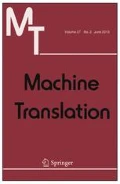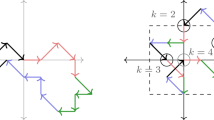Abstract
We study the computational complexity of the Viterbi alignment and relaxed decoding problems for IBM model 3, focusing on the problem of finding a solution which has significant overlap with an optimal. That is, an approximate solution is considered good if it looks like some optimal solution with a few mistakes, where mistakes can be wrong values (such as a word aligned incorrectly or a wrong word in decoding), as well as insertions and deletions (spurious/missing words in decoding). In this setting, we show that it is computationally hard to find a solution which is correct on more than half (plus an inverse polynomial fraction) of the words. More precisely, if there is a polynomial-time algorithm computing an alignment for IBM model 3 which agrees with some Viterbi alignment on \(l/2+l^\epsilon \) words, where l is the length of the English sentence, or producing a decoding with \(l/2+l^\epsilon \) correct words, then P \(=\) NP. We also present a similar structure inapproximability result for phrase-based alignment. As these strong lower bounds are for the general definitions of the Viterbi alignment and decoding problems, we also consider, from a parameterized complexity perspective, which properties of the input make these problems intractable. As a first step in this direction, we show that Viterbi alignment has a fixed-parameter tractable algorithm with respect to limiting the range of words in the target sentence to which a source word can be aligned. We note that by comparison, limiting maximal fertility—even to three—does not affect NP-hardness of the result.


Similar content being viewed by others
References
Berman L, Hartmanis J (1977) On isomorphisms and density of NP and other complete sets. SIAM J Comput 6(2):305–322
Birch A, Callison-Burch C, Osborne M, Koehn P (2006) Constraining the phrase-based, joint probability statistical translation model. In: HLT-NAACL 2006: proceedings of the workshop on statistical machine translation, New York, pp 154–157
Brown PF, Della Pietra VJ, Della Pietra SA, Mercer RL (1993) The mathematics of statistical machine translation: parameter estimation. Comput Linguist 19(2):263–311
Buss JF, Islam TM (2008) The complexity of fixed-parameter problems: guest column. SIGACT News 39(1):33–46. doi:10.1145/1360443.1360454
Cesati M (2006) Compendium of parameterized problems. http://www.sprg.uniroma2.it/home/cesati/research/compendium/compendium.pdf
DeNero J (2010) Phrase alignment models for statistical machine translation. PhD Thesis, UC Berkeley, CA
DeNero J, Klein D (2008) The complexity of phrase alignment problems. In: ACL-08: HLT. Proceedings of the 46th annual meeting of the association for computational linguistics on human language technologies: short papers, Columbus, pp 25–28
Downey RG, Fellows MR (1992) Fixed-parameter intractability. In: Proceedings of the seventh annual conference on structure in complexity theory, Victoria, pp 36–49
Feige U, Langberg M, Nissim K (2000) On the hardness of approximating NP witnesses. In: Approx 2000: approximation algorithms for combinatorial optimization. Proceedings of third international workshop. Lecture notes in computer science 1913. Springer, New York, pp 120–131
Gal A, Halevi S, Lipton RJ, Petrank E (1999) Computing from partial solutions. In: COCO ’99: proceedings of the fourteenth annual IEEE conference on computational complexity, Atlanta, pp 34–45
Guruswami V, Rudra A (2008) Soft decoding, dual BCH codes, and better list-decodable \(\varepsilon \)-biased codes. In: CCC 2008: proceedings of the twenty-third annual IEEE conference on computational complexity, College Park, pp 163–174
Hamilton M, Müller M, van Rooij I, Wareham T (2007) Approximating solution structure. In: Demaine E, Gutin GZ, Marx D, Stege U (eds) Structure theory and FPT algorithmics for graphs, digraphs and hypergraphs, No. 07281 in Dagstuhl seminar proceedings. Internationales Begegnungs- und Forschungszentrum für Informatik (IBFI). Schloss Dagstuhl, Germany, Dagstuhl
Knight K (1999) Decoding complexity in word-replacement translation models. Comput Linguist 25(4):607–615
Koehn P (2004) Pharaoh: a beam search decoder for phrase-based statistical machine translation models. In: Machine translation: from real users to research: 6th conference of the Association for Machine Translation in the Americas. Springer, Berlin, pp 115–124
Koehn P, Och FJ, Marcu D (2003) Statistical phrase-based translation. In: HLT-NAACL 2003: conference combining human language technology conference series and the North American Chapter of the Association for Computational Linguistics conference series. Proceedings, Edmonton, pp 48–54
Kuhn HW (1955) The Hungarian method for the assignment problem. Naval Res Logist Q 2:83–97
Kumar R, Sivakumar D (1999) Proofs, codes, and polynomial-time reducibilities. In: COCO ’99: proceedings of the fourteenth annual IEEE conference on computational complexity, Atlanta, pp 46–53
Lopez A (2008) Statistical machine translation. ACM Comput Surv 40(3):1–49
MacCartney B, Galley M, Manning CD (2008) A phrase-based alignment model for natural language inference. In: Proceedings of the conference on empirical methods in natural language processing. Association for Computational Linguistics, pp 802–811
Marcu D, Wong W (2002) A phrase-based, joint probability model for statistical machine translation. In: EMNLP-2002: proceedings of the 2002 conference on empirical methods in natural language processing, Philadelphia, pp 133–139
Och FJ, Ney H (2003) A systematic comparison of various statistical alignment models. Comput Linguist 29(1):19–51
Ravi S, Knight K (2010) Does giza++ make search errors? Comput Linguist 36(3):295–302
Sheldon D, Young NE (2013) Hamming approximation of NP witnesses. Theory Comput 9(22):685–702
Søgaard A (2009) On the complexity of alignment problems in two synchronous grammar formalisms. In: Proceedings of the third workshop on syntax and structure in statistical translation (SSST-3) at NAACL HLT 2009, Boulder, pp 60–68
Udupa R, Maji H (2005) Theory of alignment generators and applications to statistical machine translation. In: Proceedings of the 19th international joint conference on artificial intelligence, Edinburgh, pp 1142–1147
Udupa R, Maji HK (2006) Computational complexity of statistical machine translation. In: EACL-2006: 11th conference of the European chapter of the Association for Computational Linguistics, proceedings of the conference, Trento, pp 25–32
van Rooij I, Wareham T (2012) Intractability and approximation of optimization theories of cognition. J Math Psychol 56(4):232–247
Acknowledgments
We are very grateful to the anonymous referees and the editor of the Machine Translation journal for suggesting a more relevant setting to apply our techniques, and pointing us to the literature. We also want to thank Todd Wareham, Valentine Kabanets and Russell Impagliazzo for numerous discussions and suggestions, and to Venkat Guruswami for telling us about then-unpublished work of Sheldon and Young.
Author information
Authors and Affiliations
Corresponding author
Rights and permissions
About this article
Cite this article
Fleming, N., Kolokolova, A. & Nizamee, R. Complexity of alignment and decoding problems: restrictions and approximations. Machine Translation 29, 163–187 (2015). https://doi.org/10.1007/s10590-015-9172-5
Received:
Accepted:
Published:
Issue Date:
DOI: https://doi.org/10.1007/s10590-015-9172-5




